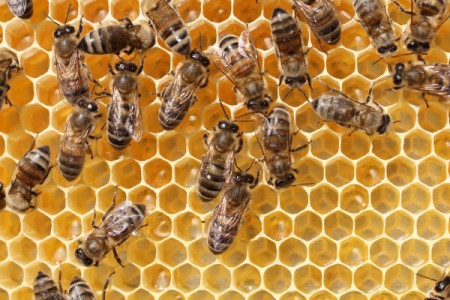 Honeybees, as we know them today, have been pollinating flowers for more than 60 million years. Without these remarkable insects, as many as two-thirds of the plant species in the world and roughly a third of the average U.S. diet would simply disappear.
Honeybees, as we know them today, have been pollinating flowers for more than 60 million years. Without these remarkable insects, as many as two-thirds of the plant species in the world and roughly a third of the average U.S. diet would simply disappear.

There are three types of bees in a honeybee hive: one queen, the male drones, and lots and lots of female worker bees. The queen's sole job is to ensure the continuance of the hive. She lives her life as a reproductive machine, laying up to 2000 eggs a day, nearly three quarters of a million of them over her two year lifespan. The male drone's job is to hatch, eat, and wait around to mate with the queen. Mating is sexual suicide for the drones, as it leaves them with a mortal wound and causes their immediate death. Finally, there are the female worker bees, which make up 99% of the colony's population. They do everything else: take care of the queen, raise the young, build the honeycombs, gather the nectar, produce the honey, and guard the hive. (If you've ever been stung by a bee on the wing, it was almost certainly a female worker bee.) As the phrase suggests, the worker bees are truly busy-as-a-bee from the moment they emerge until six weeks later, when their little tired bodies and tattered wings literally die of exhaustion.
Honeybees make honey from nectar, the sugar-rich liquid, produced by flowering plants. They use their long, straw-like tongues (proboscis) to suck nectar out of flowers and into their two stomachs. A small amount of the nectar goes into the bee's regular stomach to provide them with energy. The bulk of the nectar goes into their second stomach (crop), also known as the honey stomach. This honey stomach is where the nectar is stored until the bee gets back to the hive. Depending on the availability of blooms, a honeybee may need to visit as many as 1,500 flowers in order to fill their honey stomach to capacity.
Once their honey stomachs are full, the bees return to the hive and deliver the nectar to other worker bees, which siphon off the nectar from the honeybees stomach through their mouths. These bees then chew the nectar for several minutes, adding enzymes to the nectar that make it more digestible and protect it from spoiling. After the nectar is sufficiently chewed, the bees spread the nectar onto the honeycombs for drying. The bees speed up the drying process by continuously fanning the nectar with their wings.
The decline of the honeybee population in the United States and worldwide could have far-reaching implications for food supply. While we don't yet know what is causing Colony Collapse Disorder, scientists and bee keeper alike do know that forces like habitat destruction, invasive species, the overuse of pesticides, global warming, and other environmental stresses create risks to bees.
To find out how you can help save honeybees, visit the Honeybee Conservatory's website.
Check out these photos.
Without bees, there would be worldwide, mass starvation. Their health and their abundance has been in jeopardy for years.
The bees were out in full force pollenating our fruit trees. I swear they knew I was taking their picture and avoided me quite effectively. Somehow I managed to sneak up on this little guy.
I was snapping pictures at the zoo and this one turned out really good! Honeybees are having problems these days and I never step on them since they seem to be dying out. Be nice to honeybees!
This sweetie was struggling to survive a heavy downpour in West Monroe, LA. I saw her fight to live, I put the end of my cane near enough to her so she was able to make it up the rubber portion of the tip. She climbed up and fell off twice. I was not going to give up so I laid the cane as flat as I could.
My pussy willow tree was buzzing with bees in the backyard. I got brave enough to get close to try to capture a photo.
Once in a life time. I looked out my window and this is what I saw; a swarm of bees on my flower bush. I called a beekeeper, but they left while I was giving directions to my home for him to get them. We took this picture there can be 1,500 to 30,000 bees in each swarm.
These passion flowers came up in one of our flowerbeds. As soon as the flowers began opening up, the bees became very "passionate" about them. They apparently have not left the flowers as we came to notice them on them in the dormant state when it was still dark out one morning.
A number of years ago I had a late flowering humming bird plant that had black and yellow bees all over it. They don't sting, but stayed busy until the first freeze, and then disappeared until this year.
My grandpa passed away last October, when he passed he left me all his honey bees for my aunt and the rest of the family to care for. Although my aunt takes on most of the responsibility, we all help out when we can.
This tiny little honey bee looked like he should be burning up in this flower, in my opinion. I know they're just colors, but the oranges and reds of this blossom reminded me of roasting marshmallows over a campfire.